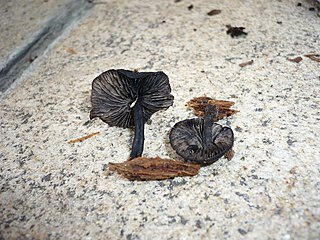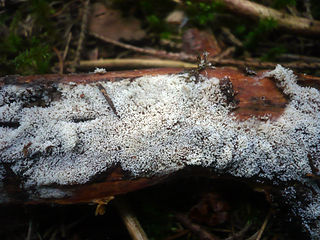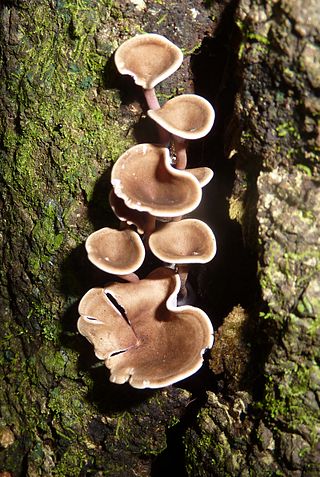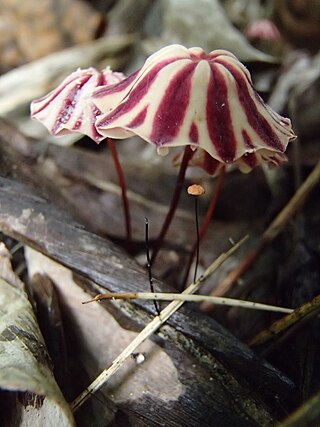
The Marasmiaceae are a family of fungi in the order Agaricales. Basidiocarps are most frequently agarics, but occasionally cyphelloid. According to a 2008 estimate, the family contained 54 genera and 1590 species, but molecular research, based on cladistic analysis of DNA sequences, has led to a more restricted family concept, so that the Marasmiaceae included just 13 genera, and some 1205 species. It was reduced further down in 2020, to 10 genera and about 700 species.

Omphalotus is a genus of basidiomycete mushroom, in the family Omphalotaceae, formally circumscribed by Victor Fayod in 1889. Members have the traditional cap and stem structure. They are saprobic, and fruit in clumps on the ground, adjacent to host trees. The best known and type species is the jack-o'-lantern mushroom (Omphalotus olearius). Species of Omphalotus have been mistaken for chanterelles. All Omphalotus species are presumed poisonous, causing gastrointestinal symptoms. Some Omphalotus species have bioluminescent properties.
Phaneromyces is a genus of lichen-forming fungi in the monotypic family Phaneromycetaceae. Phaneromyces consists of two species known from temperate South America.
Palaeocephala is a genus of fungi. This is a monotypic genus, containing the single species Palaeocephala cymatelloides, described by Rolf Singer in 1962. According to the Dictionary of the Fungi, the genus is classified in either the Marasmiaceae or Physalacriaceae families; the taxonomical database MycoBank includes it in the Marasmiaceae.

Clitocybula is a genus of mushroom-forming fungi in the family Porotheleaceae but was originally classified within Marasmiaceae. The genus was circumscribed by Georges Métrod in 1952. Species in the genus are commonly known as "coincaps".
Deigloria is a genus of agaric fungus in the family Marasmiaceae. Described by mycologist Reinhard Agerer in 1980, the genus contains 10 species that are widespread in neotropical areas. The generic name derives from the Latin words Deus (God) and gloria (glory).
Epicnaphus is a genus of mushroom-forming fungi in the family Marasmiaceae. The genus, circumscribed by mycologist Rolf Singer in 1960, contains two species found in South America. Fruitbodies of Epicnaphus species are similar in appearance to those in Marasmius section Sicci, but have a smooth hymenium and broom cells of the Rotalis-type. Singer initially included only the type species, E. phalaropus, which was originally collected from fallen branches in a Bolivian rainforest. The Argentinian species E. longispora was added to the genus by Jörg Raithelhuber in 1973.
Fissolimbus is a fungal genus in the family Marasmiaceae. This is a monotypic genus, containing the single species Fissolimbus fallaciosus, found in Papua New Guinea. The genus and species were described as new to science in 1979.

Henningsomyces is a genus of fungi in the family Marasmiaceae.

Hydropus is a genus of fungi in the family Marasmiaceae. The widespread genus contains about 100 species, especially in tropical areas, but is not well represented in temperate regions. About 15 taxa are found in Europe; H. floccipus has the widest distribution in western Europe. Hydropus was circumscribed by Rolf Singer in 1948. Species in the genus have fruit bodies with caps that are mycenoid, collybioid, or omphaloid in form. Most species occur in tropical and subtropical regions, where they grow as saprobes on rotting wood, forest litter, and mosses. Generally, most Hydropus species are rare, and several are known only from the type collection, including H. conicus, H. moserianus, H. nitens, and H. paradoxus.

Moniliophthora is a genus of fungi in the family Marasmiaceae. The genus was described in 1978 with M. roreri as the type species. This fungus, formerly known as Monilia roreri, causes frosty pod rot, a serious disease of Theobroma cacao.
Pseudotyphula is a genus of fungus in the family Marasmiaceae. The genus is monotypic, containing the single species Pseudotyphula ochracea, found in North America. The genus was circumscribed by British mycologist E.J.H. Corner in 1953.

Rectipilus is a genus of cyphelloid fungi in the family Marasmiaceae. The widespread genus contains nine species. It was circumscribed by Reinhard Agerer in 1973.

Trogia is a genus of fungi in the family Marasmiaceae. It is named after a Swiss mycologist Jacob Gabriel Trog. The genus contains about 20 species that are widely distributed in tropical areas.

Skeletocutis is a genus of about 40 species of poroid fungi in the family Polyporaceae. The genus has a cosmopolitan distribution, although most species are found in the Northern Hemisphere. It causes a white rot in a diverse array of woody substrates, and the fruit bodies grow as a crust on the surface of the decaying wood. Sometimes the edges of the crust are turned outward to form rudimentary bracket-like caps.

Hymenogloea is a fungal genus in the family Marasmiaceae. The genus is monotypic, containing the single species Hymenogloea riofrioi, found in tropical America.

Campanella is a genus of fungi in the family Marasmiaceae. The genus has a widespread distribution, especially in tropical regions, and contains about 40 species.

Marasmius tageticolor is a species of agaric fungus in the family Marasmiaceae. Its fruit bodies have striped red and white caps. It is found in Mexico, Central America, and South America, where it grows on twigs.

Lactocollybia subvariicystis is a fungus in the Lactocollybia genus. Species in this genus are little known in China. This species is reported from subtropical south China in 2016. It is characterized by its small, white, hygrophanous basidiomata, sinuate to adnexed lamellae, common presence of gloeocystidia in the context of pileus, lamellae and stipe which is sharply tapering at both ends, and found on the living trunk of Acacia confusa.













